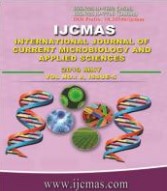


 National Academy of Agricultural Sciences (NAAS)
National Academy of Agricultural Sciences (NAAS)

|
PRINT ISSN : 2319-7692
Online ISSN : 2319-7706 Issues : 12 per year Publisher : Excellent Publishers Email : editorijcmas@gmail.com / submit@ijcmas.com Editor-in-chief: Dr.M.Prakash Index Copernicus ICV 2018: 95.39 NAAS RATING 2020: 5.38 |
Remote sensing is very useful to collect information about water resource and to manage it by satellite data. In this paper, study has been carried out for Ramganga reservoir using Landsat 8 imagery for spatiotemporal mapping. The imagery has been collected from 2013 to 2018 for pre-monsoon and post monsoon season. The reservoir, under study, is presently used for hydroelectric purpose and irrigation. Landsat-8 images which were cloud free has been taken for the study. The study is carried out on QGIS platform and Normalized Difference Vegetation Index (NDVI) has been used to map water spread area of the reservoir. Results of this study suggested that in pre-monsoon session, maximum water spread area of 59.81 km2was in 2014 whereas year 2017 has shown minimum water spread area of 3.18 km2 for pre-monsoon session. In post monsoon session, year 2014 shows maximum water spread area of68.53 km2 the reservoir whereas year 2016 shows minimum water spread area of 53.97 km2. The average water spread area of the reservoir in pre-monsoon was 40.01km2 and in post-monsoon was 61.84 km2. The results also suggested that NDVI could be used with accuracy to extract water features and also the spread area.
 |
 |
 |
 |
 |